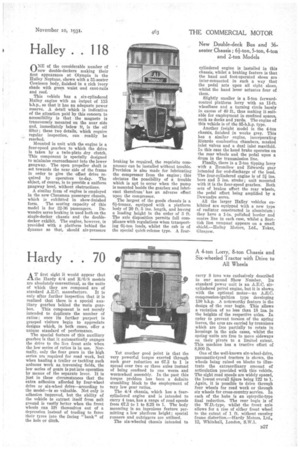Hardy . . 70
Page 17

If you've noticed an error in this article please click here to report it so we can fix it.
ATfirst sight it would appear that the Hardy 4/4 and R/6/8 models are absolutely conventional, as the units of which they are composed are of
standard A.E.C. manufacture. It is only after further inspection that it is realized that there is a special auxiliary gearbox behind the main gearbox. This component is not merely intended to duplicate the number of ratios ; once its further purport is grasped visitors begin to appreciate designs which, in both cases, offer a unique standard of performance.
The special feature of this auxiliary gearbox is that it automatically engages the drive to the live front axle when the low series of ratios is in use. Normally, only the four gears in the high series are required for road work, but when hauling a trailer or tackling such arduous work as traversing fields, the low series of gears is put into operation by means of the separate lever. It is just in these circumstances that the extra adhesion afforded by four-wheel drive or six-wheel drive—according to the model—is so valuable. Not only is adhesion improved, but the ability of the vehicle to extract itself from soft ground is vastly better when the front wheels can lift themselves out of a depression instead of tending to force their tyres into the facing "bank" of the hole or ditch.
Yet another good point is that the very powerful torque exerted through such gear reduction as 67.3 to 1 is spread over two or three axles instead of being confined to one worm and wormwheel assembly. In the past this torque problem has been a definite stumbling block to the employment of very low gear ratios.
The 4/4 chassis, which has a fourcylindered engine and is intended to carry 4 tons, has a range of road speeds from 67.3 to 1 to 825 to 1. The body mounting is an ingenious feature permitting a low platform height; special runners and outriggers are utilized.
The six-wheeled chassis intended to
carry 8 tons was exclusively described in our second Show Number. Its standard power unit is an AE.C. sixcylindered petrol engine, but it is shown with the optional motor—an A.B.C. compression-ignition type developing 130 b.h.p. A noteworthy feature is the design of the rear bogie. This allows a variation of no less than 18 ins, in the heights of the respective axles. In o,rder to prevent torsion of the spring leaves, the eyes are carried by trunnions which are free partially to rotate in housings in the axle cases, whilst the spring'units are free to move sideways on their pivots to a limited extent. This machine has a tractive effort of 8,900 lb.
One of the well-known six-wheel-drive, pneumatic-tyrecl tractors is shown, the wheels being raised on blocks to illustrate the extraordinary amount of articulation provided with this vehicle. The eight road speeds are widely spaced, the lowest overall figure being 122 to 1. Again, it is possible to drive through four wheels for road work or through six wheels for cross-country service. In each of the hubs is an epicyclic-type final reduction. The rear bogie is of the W.D.-type, whilst the front axle allows for a rise of either front wheel to the extent of 1 ft. without causing frame distortion.—Hardy Motors, Ltd., 12, Whitehall, London, S.W.1.
















































































































































